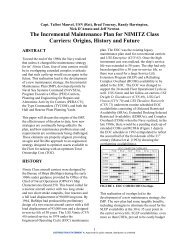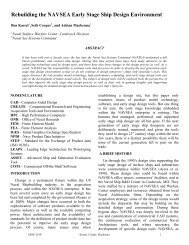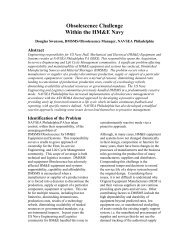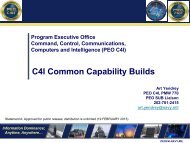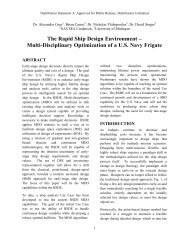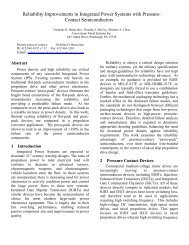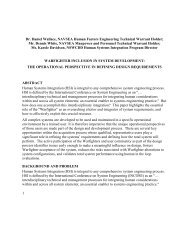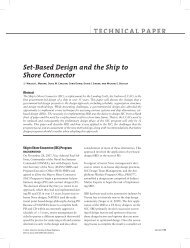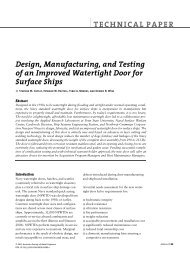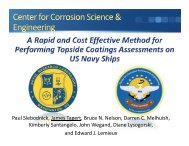The Wreck of DKM Bismarck − A Marine Forensics Analysis 1 The ...
The Wreck of DKM Bismarck − A Marine Forensics Analysis 1 The ...
The Wreck of DKM Bismarck − A Marine Forensics Analysis 1 The ...
Create successful ePaper yourself
Turn your PDF publications into a flip-book with our unique Google optimized e-Paper software.
<strong>The</strong> <strong>Wreck</strong> <strong>of</strong> <strong>DKM</strong> <strong>Bismarck</strong> <strong>−</strong> A <strong>Marine</strong> <strong>Forensics</strong> <strong>Analysis</strong><br />
were very tight, perhaps no more than 1-2 meters. This was done to allow better flow to the<br />
rudders thereby enhancing their turning ability. <strong>The</strong> rudder is also missing about 50% <strong>of</strong> its<br />
trailing structure, leading one to conclude that the fatal torpedo hit actually struck the trailing<br />
edge <strong>of</strong> that rudder whereupon it exploded or the explosion took place just inboard but between<br />
the two rudders.<br />
With the turret positions correctly identified, then the heading <strong>of</strong> the ship at the moment<br />
<strong>of</strong> sinking can be confirmed. It was on a generally northern heading during the battle, changing<br />
at times between northwest and northeast. So the closest configuration to this known range <strong>of</strong><br />
headings would put Anton to the east, with the ship sinking on a northeast heading.<br />
RUSTICLES<br />
Rusticle phenomena, first encountered during the exploration <strong>of</strong> the wreck <strong>of</strong> the Titanic,<br />
are still very imperfectly understood. As is the case for much forensic analysis, as some<br />
questions <strong>of</strong> fact are resolved, more puzzlements arise to confound and fascinate the analysts.<br />
A number <strong>of</strong> different varieties <strong>of</strong> rusticles 41 were found on the wreck <strong>of</strong> <strong>Bismarck</strong>.<br />
Rusticles are bioconcretious structures that have been found on deep-ocean wrecks like<br />
RMS Titanic and USS Yorktown (CV-6). <strong>The</strong>y involve water channels, reservoirs, iron plate-like<br />
structures, thread-like spans, porous matrices, and ducts connecting to the outside. Within these<br />
structures there appear to be a number <strong>of</strong> microbial strains <strong>of</strong> sulfate reducing bacteria, iron-<br />
related bacteria, heterotropic aerobic bacteria, denitrifying bacteria, and archaeobacteria. <strong>The</strong>re<br />
are different bacteria consortia on the wreck <strong>of</strong> <strong>Bismarck</strong> with strikingly differing colors. <strong>The</strong>se<br />
bacteria exist together with a range <strong>of</strong> fungi 42 .<br />
Most areas with no structural damage have very little rusticle development. <strong>The</strong>re are a<br />
few areas with little or no structural damage that have a great deal <strong>of</strong> rusticle activity. It is<br />
believed that these represent fire-damaged areas. <strong>The</strong> general impression is that rusticles have<br />
invaded burn-damaged areas.<br />
Rusticles have attacked severed edges <strong>of</strong> hull steel. Buckling and separation <strong>of</strong> thick<br />
armor plates allows rusticles to attack edges. Rusticles do not always attack "splash" marks from<br />
splinter hits, even though bare metal is present. Is there a chemical residue that may be negative<br />
to rusticle growth?<br />
Rusticle activity varies widely in different areas <strong>of</strong> ship. Some areas seem completely<br />
unaffected. <strong>The</strong> areas <strong>of</strong> greatest structural damage from explosions have almost complete<br />
rusticle involvement.<br />
Photographic images taken by ROVs Jake and Elwood show that rusticle growth inside<br />
the wreck is equivalent to that on Titanic, and is very mature. Almost no interior paint is still<br />
visible except in the transverse corridor running athwartship beneath the seaplane catapult.<br />
Rusticles are about one meter long. Interior rusticles seem to grow as pr<strong>of</strong>usely in structurally<br />
intact areas as well as heavily damaged locations, indicating that paint thickness may be a factor.<br />
Fire damage may also be a contributor.<br />
41<br />
First named by Dr. Robert Ballard in 1986 when he explored the wreck <strong>of</strong> the RMS Titanic because <strong>of</strong><br />
their likeness to icicles.<br />
42<br />
“<strong>The</strong> Impact <strong>of</strong> Bioconcretious Structures (Rusticles) for the RMS Titanic: Implications for Maritime<br />
Steel Structures,” by Dr. Roy Cullimore and Kori Johnston. Transactions <strong>of</strong> the Society <strong>of</strong> Naval<br />
Architects and <strong>Marine</strong> Engineers, Volume 107, 2000, pp 179-195.<br />
48



